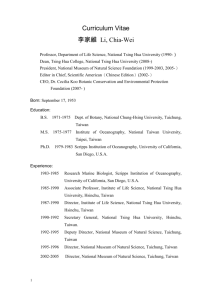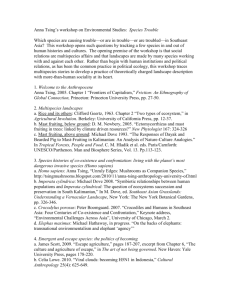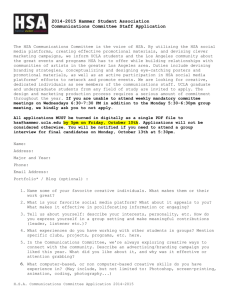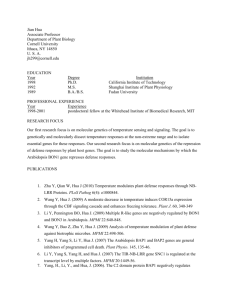Compiler Enhancements For Productivity & Performance
advertisement
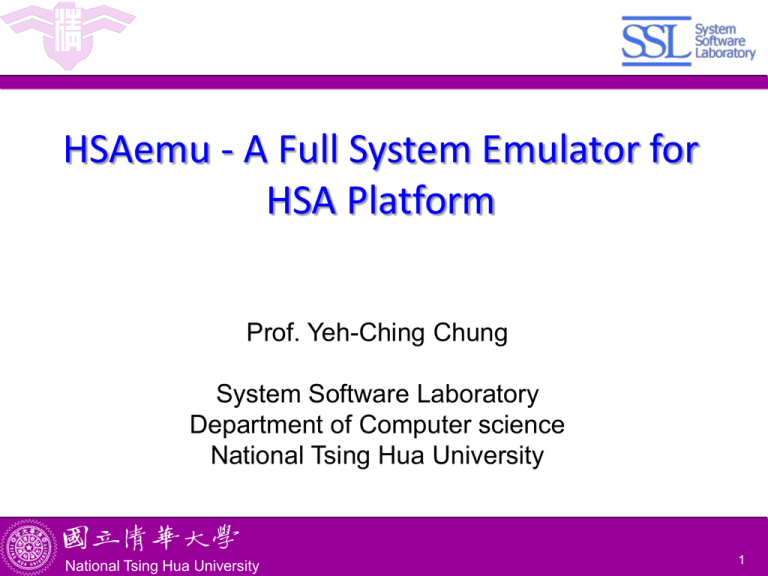
HSAemu - A Full System Emulator for HSA Platform Prof. Yeh-Ching Chung System Software Laboratory Department of Computer science National Tsing Hua University National Tsing Hua University ® copyright OIA National Tsing Hua University 1 Outline Introduction to HSA Design of HSAemu Performance Evaluation Conclusions and Future Work National Tsing Hua University ® copyright OIA National Tsing Hua University 2 Introduction to HSA HSA Foundation is a non-profit industry standards body to create software/hardware standards for heterogeneous computing – simplify the programing environment – make compute at low power pervasive – introduce new capabilities in modern computing devices Core founders include AMD, ARM, Imagination Technology, MediaTek, Qualcomm, Samsung, and Texas Instruments Open membership to deliver royalty free specifications, and API’s Founded June 12, 2012 National Tsing Hua University ® copyright OIA National Tsing Hua University 3 Members of HSA Foundation – 2014/6 Membership consists of 43 companies and 16 universities Adding 1-2 new members each month Founders Needs Updating – Add Toshiba Logo Promoters Supporters Contributors Academic National Tsing Hua University ® copyright OIA National Tsing Hua University 4 HSA Foundation’s Initial Focus (1) Heterogeneous SOCs have arrived and are a tremendous advance over previous platforms SOCs combine CPU cores, GPU cores and other accelerators, with high bandwidth access to memory How do we make them even better? – – – – Easier to program Easier to optimize Higher performance Lower power National Tsing Hua University ® copyright OIA National Tsing Hua University 5 HSA Foundation’s Initial Focus (2) HSA unites accelerators architecturally – Bring the GPU forward as a first class processor • • • • • • • Unified coherent address space (hUMA) User mode dispatch/scheduling Can utilize pagable system memory Fully coherent memory between the CPU and GPU Pre-emption and context switching Relaxed consistency memory model Quality of Service Attract mainstream programmers – Support broader set of languages beyond traditional GPGPU languages – Support for task parallel runtimes & nested data parallel programs – Rich debugging and performance analysis support National Tsing Hua University ® copyright OIA National Tsing Hua University 6 HSA Foundation’s Initial Focus (3) Early focus on the GPU compute accelerator, but HSA will go well beyond the GPU Audio Processo r CPU SM&C GPU Video Hardwar e Security Processor Shared Memory and Coherency Fixed Function Accelerat or National Tsing Hua University ® copyright OIA National Tsing Hua University DSP Image Signal Processing 7 Pillars of HSA* Unified addressing across all processors Operation into pageable system memory Full memory coherency User mode dispatch Architected queuing language Scheduling and context switching HSA Intermediate Language (HSAIL) High level language support for GPU compute processors National Tsing Hua University ® copyright OIA National Tsing Hua University 8 HSA Specifications HSA System Architecture Specification – Version 1.01, released March 16, 2015 – Defines discovery, memory model, queue management, atomics, etc HSA Programmers Reference Specification – Version 1.02, released March 16, 2015 – Defines the HSAIL language and object format HSA Runtime Software Specification – Version 1.0, released March 16, 2015 – Defines the APIs through which an HSA application uses the platform All released specifications can be found at the HSA Foundation web site: – www.hsafoundation.com/standards National Tsing Hua University ® copyright OIA National Tsing Hua University 9 hQ and hUMA National Tsing Hua University ® copyright OIA National Tsing Hua University 10 HSA Intermediate Layer — HSAIL HSAIL is a virtual ISA for parallel programs – Finalized to ISA by a JIT compiler or “Finalizer” – ISA independent by design for CPU & GPU Explicitly parallel – Designed for data parallel programming Support for exceptions, virtual functions, and other high level language features Lower level than OpenCL SPIR – Fits naturally in the OpenCL compilation stack Suitable to support additional high level languages and programming models: – Java, C++, OpenMP, C++, Python, etc National Tsing Hua University ® copyright OIA National Tsing Hua University 11 HSA Memory Model Defines visibility ordering between all threads in the HSA System Designed to be compatible with C++11, Java, OpenCL and .NET Memory Models Relaxed consistency memory model for parallel compute performance Visibility controlled by: – Load.Acquire – Store.Release – Fences National Tsing Hua University ® copyright OIA National Tsing Hua University 12 HSA Queuing Model User mode queuing for low latency dispatch – Application dispatches directly – No OS or driver required in the dispatch path Architected Queuing Layer – Single compute dispatch path for all hardware – No driver translation, direct to hardware Allows for dispatch to queue from any agent – CPU or GPU GPU self enqueue enables lots of solutions – Recursion – Tree traversal – Wavefront reforming National Tsing Hua University ® copyright OIA National Tsing Hua University 13 HSA Runtime The HSA core runtime is a thin, user-mode API that provides the interface necessary for the host to launch compute kernels to the available HSA components. The overall goal of the HSA core runtime design is to provide a high-performance dispatch mechanism that is portable across multiple HSA vendor architectures. – The dispatch mechanism differentiates the HSA runtime from other language runtimes by architected argument setting and kernel launching at the hardware and specification level. – The HSA core runtime API is standard across all HSA vendors, such that languages which use the HSA runtime can run on different vendor’s platforms that support the API. National Tsing Hua University ® copyright OIA National Tsing Hua University 14 HSA Platform National Tsing Hua University ® copyright OIA National Tsing Hua University 15 Simplified HSA Software Stack National Tsing Hua University ® copyright OIA National Tsing Hua University 16 First HSA APU National Tsing Hua University ® copyright OIA National Tsing Hua University 17 What Is HSAemu HSAemu is a full system emulator that supports the following HSA features – Shared virtual memory between CPU and GPU – Memory based signaling and synchronization – Multiple user level command queues – Preemptive GPU context switching – Concurrent execution of CPU threads and GPU threads – HSA runtime – Finalizer A project sponsored by MediaTek (MTK) Currently, it supports simple HSA platform simulation – – Functional-accurate simulation Cycle-accurate simulation National Tsing Hua University ® copyright OIA National Tsing Hua University 18 Goals of HSAemu Verify software stack implementation – Tool chain/SDK – HSA runtime – Finalizers Assist application software development in parallel to hardware development – HSA feature support – functional correctness guaranteed Easy to plug-in different simulators/emulators – Provide a command buffer interface National Tsing Hua University ® copyright OIA National Tsing Hua University 19 Architecture of HSAemu HSAemu consists of 9 components – HSAIL Off-line Compiler – HSA Runtime – HSA Driver – HSA Finalizer – CPU Simulation Module – GPU Task Dispatcher – Functional-Accurate GPU Simulator (Fast-Time GPU Simulator) – Cycle-Accurate GPU Simulator (Multi2Sim) – GPU Helper Functions National Tsing Hua University ® copyright OIA National Tsing Hua University 20 OpenCL 1.2 Benchmarks AMD-APPSDK OpenCL benchmarks – 20+ benchmarks can be run on HSAemu – For example: NBODY, Mandelbrot set, Histogram, etc. Rodina OpenCL benchmark – Kmeans, Gaussian…etc National Tsing Hua University ® copyright OIA National Tsing Hua University 21 Compliation Framework (1) OpenCL Kernel HSAIL Compiler HSAIL HSAIL Decoder BRIG HSAIL Finalizer Device Native National Tsing Hua University ® copyright OIA National Tsing Hua University • HSAIL Compiler • Convert OpenCL kernel to HSAIL • HSAIL Decoder • Convert HSAIL to binary format (BRIG) • HSAIL Finalizer • Finalize the BRIG to the real ISA which is selected by the HSA Runtime 22 Compliation Framework (2) Components and compilation flow OpenCL Kernel CL2HSAIL HSAIL Text HSAIL2BRIG HSAIL Binary (BRIG) OpenCL 2.0 Runtime HSAIL Finalization BRIG2OBJ Object File HSA Runtime Kernel Descriptor National Tsing Hua University ® copyright OIA National Tsing Hua University 23 Compliation Framework (3) CL2HSAIL – – – CL2HSAIL is based on LLVM Compiling OpenCL to LLVM should include a self-defined OpenCL library header Use LLVM backend and HSAIL Target module to translate LLVM to HSAIL Clang OpenCL Kernel Llc HSAIL Text LLVM IR HSAIL Target include Built-In Function Library OpenCL Type Header Library Library Header National Tsing Hua University ® copyright OIA National Tsing Hua University 24 Compliation Framework (4) HSAIL2BRIG – Based on Lex and Yacc BRIG is an ELF format binary file following HSAIL specification HSAIL Text National Tsing Hua University ® copyright OIA National Tsing Hua University HSAIL2BRIG HSAIL Binary (BRIG) 25 Compliation Framework (4) BRIG2OBJ is based on LLVM – Flow Constructor: Covert BRIG to control flow tree – Hdecoder: Covert control flow tree to LLVM bitcode – Hassembler: Covert LLVM bitcode to host native HSAIL Binary (BRIG) BRIG2OBJ Flow Constructor HDecoder National Tsing Hua University ® copyright OIA National Tsing Hua University LLVM BitCode HAssembler Object File 26 HSAIL Finalization (1) HSAIL Finalization BRIG BRIG2OBJ Flow Constructor OpenCL Runtime Control Flow Tree HSA Runtime BRIG2OBJ Link to Helper Functions Call the Coresponding HSA Runtime Loader Read BRIG File, Generate The Kernel Descriptor And Launch BRIG2OBJ Store The Target Binary Code to Code Cache Linker Translate LLVM IR to LLVM Target Object File HDecoder Construct The Control Flow Graph of HSAIL Program LLVM BitCode HAssembler Translate HSAIL to LLVM IR Load Target Object File descriptor National Tsing Hua University ® copyright OIA National Tsing Hua University Code Cache Target Executable Object File 27 HSAIL Finalization (2) Host SSE instruction Optimization – Reconstruct the control flow graph of kernel function – Use bitmap masking and packing/unpacking algorithms to generate host SSE instructions Example : The control flow graph for kernel function $foo National Tsing Hua University ® copyright OIA National Tsing Hua University 28 HSAIL Finalization (3) Reconstruct the control flow graph by depth-first traversal Perform bitmap masking and packing & unpacking algorithms National Tsing Hua University ® copyright OIA National Tsing Hua University 29 OpenCL Runtime Most of OpenCL 1.2 APIs were implemented – Based on the Multi2Sim runtime architecture In OpenCL APIs, they call HSA runtime APIs to do the tasks – OpenCL device init -> hsa_init API – OpenCL command queue -> hsa_queue and AQL packet National Tsing Hua University ® copyright OIA National Tsing Hua University 30 HSA Runtime Follow the HSA runtime specification v1.0 The following features were implemented – HSA init and shutdown – HSA notification mechanism – HSA system and agent information – HSA queue – HSA AQL packet – HSA signal – HSA memory National Tsing Hua University ® copyright OIA National Tsing Hua University 31 HSA Driver Command buffer packet HSA Driver – Provide hardware information for HSA runtime – Provide Memory Operation for HSA runtime – Pack AQL packets to a command – Dispatch command to Command Buffer National Tsing Hua University ® copyright OIA National Tsing Hua University 32 CPU Simulation Module (1) Act as an HSA host – PQEMU National Tsing Hua University ® copyright OIA National Tsing Hua University Agent code, HSA runtime, and operating system are running on PQEMU 33 CPU Simulation Module (2) PQEMU – A parallel system emulator based on QEMU – Can simulate up to 256 cores – Dynamic binary translation (DBT) technique – A project sponsored by MTK Code Cache National Tsing Hua University ® copyright OIA National Tsing Hua University DBT DBT DBT DBT CPU CPU CPU CPU 34 CPU simulation Module (3) HSA Signal Handler – Receive doorbell signal from HSA runtime and decode the signal handle (start kernel program) – Encode completion signal, and send it to the user program (finish kernel program) – Inform command packet processor to process commands National Tsing Hua University ® copyright OIA National Tsing Hua University 35 GPU Task Dispatcher (1) Command packet Command Buffer – Define command buffer interface for easy emulator/simulator plug-in • MMIO, syscall, interrupt…etc – Receive the command packets from applications • A command packet contains device id , opcode, and AQL packets which are enqueued by HSA runtime National Tsing Hua University ® copyright OIA National Tsing Hua University 36 GPU Task Dispatcher (2) Command packet processor – Fetch command packets from – – – – – National Tsing Hua University ® copyright OIA National Tsing Hua University Command Buffer (FIFO) Decode the command packets to extract AQL packet or custom data Copy kernel object (executable code) to shared virtual memory Link kernel object to emulator Put kernel object to code cache Dispatch jobs to HSA kernel agents or other emulation engines 37 Fast-Time GPU Simulator (1) Simulate a generic GPU model – The schedule unite assigns work groups to free CU threads in the GPU Thread Pool – Each CU thread executes all work items in a work group – The maximum number of CU threads is limited by host operating system National Tsing Hua University ® copyright OIA National Tsing Hua University 38 Fast-Time GPU Simulator (2) Schedule Unit – Master of compute units – Manages a centralized work pool – Treat a workgroup data as a atomic task(a workgroup as a basic unit) – Use spinlock to keep the synchronization of compute unit threads – Task distribution order is according to workgroup number order (increment order) National Tsing Hua University ® copyright OIA National Tsing Hua University 39 Fast-Time GPU Simulator (3) Compute Unit – Standalone thread – Has its own MMU (IOMMU) for share virtual memory access – Send the completion signal to HSA Signal Handler (CompletetionSignal) when job is done – Profile job information (TLB Hits/Misses) National Tsing Hua University ® copyright OIA National Tsing Hua University 40 M2S-GPU Simulator (1) A cycle-accurate simulator for AMD Southern Islands GPU model simulation – M2S Bridge • Bridge Multi2Sim GPU Model to HSAemu – M2S GPU Module • Simulate a cycle-accurate GPU model National Tsing Hua University ® copyright OIA National Tsing Hua University 41 M2S-GPU Simulator (2) M2S Bridge : An interface to launch M2S GPU Module – Initialize the data structures used by AMD Southern Islands GPU, including a memory register for AMD Southern Islands GPU to access the shared system memory in HSAemu – Invoke M2S GPU Module (the AMD Southern Islands GPU module in Multi2Sim) National Tsing Hua University ® copyright OIA National Tsing Hua University 42 M2S-GPU Simulator (3) M2S GPU Module – A cycle-accurate AMD Southern Islands GPU simulator in Multi2Sim National Tsing Hua University ® copyright OIA National Tsing Hua University Memory access is performed by HSAemu memory helper function to comply the hUMA model 43 GPU Helper Functions (1) Memory Helper Function – A soft-mmu of GPU with a page table worker and a TLB to enable hUMA model – Support the redirect access of a local segment memory to a non-shared private memory in GPU Kernel Information Helper Function – Collect and return information of GPU simulation and current execution state – Retrieve kernel information such as working item ID, work group size, etc, from AQL packet National Tsing Hua University ® copyright OIA National Tsing Hua University 44 GPU Helper Functions (2) Mathematic Helper Function – Simulate special mathematical instructions such as trigonometric instructions by calling the corresponding mathematical functions in standard library Synchronization Helper Function – Barrier synchronization implementation for generic GPU model simulation National Tsing Hua University ® copyright OIA National Tsing Hua University 45 Performance Evaluation Experimental Environment Benchmarks: – Nearest Neightbor (NN), K-Means, FFT, FWT, N-Body – Binary Search, Bitonic Sort, Reduction, FWT National Tsing Hua University ® copyright OIA National Tsing Hua University 46 Scalability of Fast-Time GPU Simulator Comparison of NN, K-means and FWT benchmarks on 32 physical cores The speedup is scalable when # of CU threads < # of host physical cores National Tsing Hua University ® copyright OIA National Tsing Hua University 47 SSE Optimization of Fast-Time GPU Simulator Performance comparison of FFT when turn on/off SSE optimization National Tsing Hua University ® copyright OIA National Tsing Hua University 48 N-Body Simulation by Fast-Time GPU Simulator N-Body Simulation All of host physical CPUs are running National Tsing Hua University ® copyright OIA National Tsing Hua University 49 Comparison of HSAemu and Multi2Sim (1) National Tsing Hua University ® copyright OIA National Tsing Hua University 50 Comparison of HSAemu and Multi2Sim (2) National Tsing Hua University ® copyright OIA National Tsing Hua University 51 Conclusions An HSA-compliant full system emulator has been implemented – A functional-accurate simulator for generic GPU model – A cycle-accurate simulator for AMD Southern Islands GPU model (from Multi2Sim) An HSA tool chain/SDK for OpenCL 1.2 Easy to plug-in different simulators/emulators – Provide a command buffer interface National Tsing Hua University ® copyright OIA National Tsing Hua University 52 Future work OpenCL 2.0 support Enhance HSAemu by implementing more HSA features Integrate HSAemu with some existing cycle-accurate GPU simulators Design a cycle-accurate simulator based on PQEMU for generic CPU model Deisgn a cycle-accurate simulator based on PQEMU for big.LITTLE CPU model National Tsing Hua University ® copyright OIA National Tsing Hua University 53 Q&A National Tsing Hua University ® copyright OIA National Tsing Hua University 54
